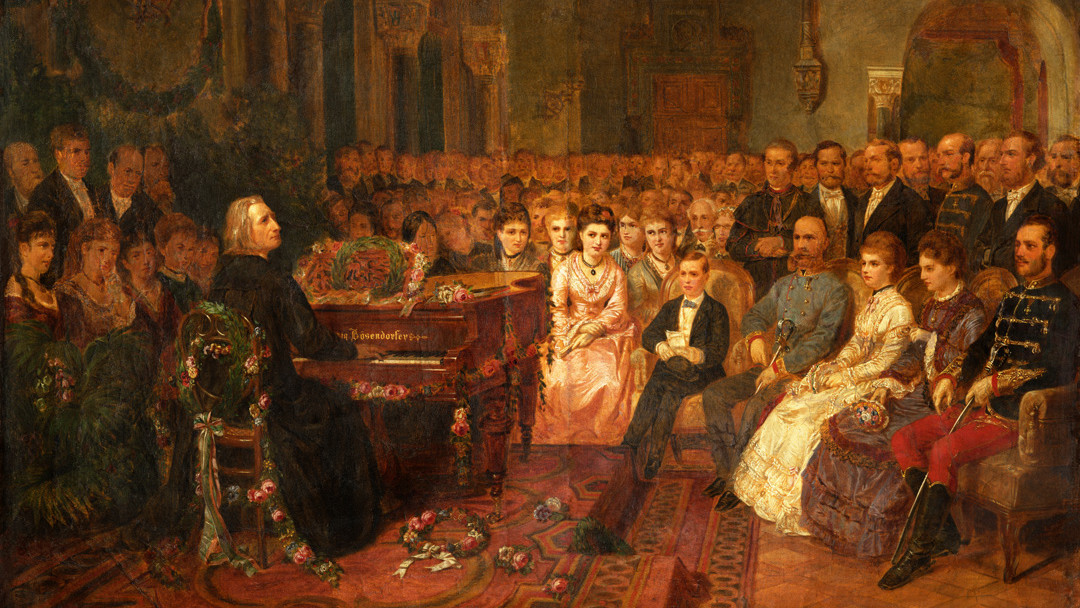
Một đêm hòa nhạc đáng nhớ:
Nghệ sĩ tài năng trẻ Franz Liszt, nổi tiếng với lối chơi đầy nhiệt huyết, được định sẵn sẽ trở thành Nghệ sĩ Bösendorfer vĩ đại đầu tiên của thời đại. Đêm nhạc này đã góp phần đáng kể vào thành công của công ty chúng tôi.
Ngày nay, nhà máy của chúng tôi cung cấp một bộ sưu tập tuyệt vời gồm 5 cây đàn Grand Piano, bắt đầu từ kích thước 170VC, 185VC, 200, 214VC đến 225, và 3 cây Concert Grand tuyệt vời với kích thước mới từ 230VC và 280VC đến cây đàn huyền thoại 290 Imperial. Hai cây đàn upright Grand Upright 120 & 130 hoàn thiện bộ sưu tập tuyệt vời của chúng tôi. Tất cả đều mang trong mình thiết kế huyền thoại.

Chân dung Ignaz Bösendorfer, người sáng lập Bösendorfer
Ignaz sinh năm 1794 tại Vienna, là con trai của thợ mộc bậc thầy Jakob và vợ là Martha Bösendorfer. Năm 19 tuổi, ông bắt đầu học nghề với Joseph Brodmann (1763 – 1848), một trong những nhà sản xuất đàn piano nổi tiếng nhất thời bấy giờ. Ignaz trẻ tuổi dường như rất có năng khiếu, và vào năm 1815, ông đã nhận được giải thưởng của Viện Hàn lâm Nghệ thuật Vienna. Cùng thời điểm đó tại Vienna có nhiều nhà sản xuất đàn piano rất nổi tiếng như Nanette và Johann Andreas Streicher, Johann Schantz, Anton Walter, Conrad Graf và Michael Schweighofer. Nhờ tích lũy được kiến thức và kỹ năng vô giá trong thời gian học nghề, Ignaz Bösendorfer tiếp quản công ty từ Joseph Brodmann, người đã nghỉ hưu ở tuổi 65 vào năm 1828.
Vào năm 1828 – năm Franz Schubert được chôn cất bên cạnh Beethoven tại Vienna – ngày 25 tháng 7, Ignaz Bösendorfer chính thức được trao quyền trở thành thành viên của hiệp hội sản xuất nhạc cụ danh tiếng của Áo tại Vienna. Đây chính là ngày thành lập chính thức của công ty sau này trở thành nhà sản xuất đàn piano hàng đầu duy nhất còn sót lại của Áo, nơi những nốt nhạc piano tuyệt vời, đầy màu sắc, lan tỏa ra toàn thế giới. Ban đầu, Ignaz Bösendorfer đầu tư 500 Gulden, một khoản đầu tư cho sự thịnh vượng, xét đến việc ông để lại cho con trai Ludwig một công ty trị giá 145.000 Gulden vào năm 1859 khi ông qua đời.

1838, Vienna: Ai cũng biết rằng không phải cây đàn piano nào cũng có thể chịu đựng được lối chơi điêu luyện, đầy nhiệt huyết của nhà soạn nhạc kiêm nghệ sĩ trẻ Franz Liszt. Được bạn bè giới thiệu, ông quyết định chọn một cây đàn Bösendorfer Grand cho buổi hòa nhạc của mình tại Vienna. Nhờ kỹ thuật chế tác tuyệt vời và chất lượng cao của Bösendorfer, Liszt không phải kìm nén tinh thần nghệ thuật của mình – điều này khiến ông ngạc nhiên. Khán giả vô cùng phấn khích. Bösendorfer trở nên nổi tiếng chỉ sau một đêm, và sau buổi hòa nhạc này, nhiều người khác sẽ nối tiếp nhau. Một tình bạn thân thiết giữa Liszt và Bösendorfer đã nảy nở.
Đàn piano vào thời điểm này – thời kỳ “Vienna Biedermeier” – không được coi là nhạc cụ dành cho sân khấu mà là nhạc cụ giải trí tại gia. Chính quyền Hoàng gia vào thời điểm này khá hạn chế và đời sống xã hội diễn ra sau những cánh cửa đóng kín. Các buổi tiệc riêng tư và các buổi tụ họp, hay nói cách khác là các sự kiện độc quyền, được tổ chức để tôn vinh các nghệ sĩ và nhà soạn nhạc địa phương, và mang đến những hoạt động giải trí đẳng cấp. Ví dụ nổi bật nhất có lẽ là Schubertiades – được đặt theo tên Franz Schubert. Đàn piano đóng một vai trò quan trọng trong những buổi tiệc này. Không có gì ngạc nhiên khi bạn có thể tìm thấy tới 387 nhà sản xuất đàn piano ở Vienna vào thời điểm đó, những người cung cấp âm nhạc, niềm vui và giải trí. Vào năm thành lập công ty (1828), Ignaz Bösendorfer đã chế tác thủ công bốn cây đàn piano và sau đó tăng sản lượng lên tổng cộng 200 cây vào năm 1835. Năm 1839, Hoàng đế Áo trao tặng Ignaz Bösendorfer danh hiệu chính thức “Nhà cung cấp đàn piano Hoàng gia và Hoàng gia cho Triều đình” – nghệ nhân piano đầu tiên được trao tặng danh hiệu này. Ông đã nhận được nhiều huy chương vàng và giải thưởng nhất.
Ignaz Bösendorfer – người sớm trở thành bạn thân của Franz Liszt và Anton Rubinstein – hoạt động rất tích cực tại Đức, Anh, Ý, Nga, Brazil và Ai Cập. Nhu cầu ngày càng tăng đối với đàn Bösendorfer Grands đã thôi thúc nghệ nhân này xây dựng một nhà máy mới. Đáng tiếc là dự án của ông đã không hoàn thành. Đến năm 1859, Ignaz qua đời, để lại xưởng sản xuất cho con trai Ludwig, người đã có nhiều kinh nghiệm quản lý. Sự ra đi của Ignaz được tất cả những người yêu nhạc Vienna thương tiếc.

Sinh ngày 10 tháng 4 năm 1835, Ludwig không chỉ được cha dạy dỗ mà còn theo học tại Học viện Bách khoa Hoàng gia ở Vienna. Những kiến thức mà Ludwig tích lũy được sau này đã được ông vận dụng hiệu quả. Năm 1860, ông phát minh ra một bộ máy cơ mới, và năm 1862, ông nhận được giải thưởng nước ngoài đầu tiên tại London cho cây đàn “Patent Grand” của mình. Năm 1867, ông tham gia Triển lãm Thế giới tại Paris. Thành công của những cây đàn piano của ông, một phần nhờ thiết kế ngoạn mục, đáng chú ý đến mức Nữ hoàng Áo Elisabeth, “Sissi”, đã đặt mua một cây đàn Bösendorfer Grand làm quà tặng cá nhân cho Hoàng hậu Eugenie của Pháp. Cây đàn này được thiết kế bởi Theophil Hansen, một kiến trúc sư nổi tiếng ở Vienna, người đã xây dựng Musikverein và Quốc hội Áo. Triển lãm Paris đã nâng cao danh tiếng của Bösendorfer trên toàn thế giới, và các điểm đến xuất khẩu bao gồm những nơi như Singapore, Rio, Stockholm và Tokyo.
Năm 1870, Bösendorfer mua lại tòa nhà tại số 14 Graf-Starhemberggasse, Quận 4, Vienna. Văn phòng và các phòng trưng bày được chuyển đến trung tâm thành phố Vienna, Palais Liechtenstein tại Herrengasse 6. Ludwig không chỉ là một nghệ nhân của Nghệ thuật Piano mà còn là một nhà bảo trợ âm nhạc và nghệ thuật. Vào ngày 19 tháng 11 năm 1872, Hans von Bülow, con rể của Liszt, đã khánh thành Bösendorfer Hall tại Palais Liechtenstein, sau khi Ludwig nhận ra chất lượng âm thanh tuyệt vời của chuồng ngựa cũ. Trong suốt 40 năm tiếp theo, các buổi hòa nhạc và độc tấu piano và nhạc thính phòng đầy niềm vui và nghệ thuật đã được tổ chức tại đây. Ban đầu được tổ chức bởi Ludwig, khoảng 4.000 buổi hòa nhạc diễn ra tại Bösendorfer Hallcounting với các nghệ sĩ như: Wilhelm Backhaus, Ferruccio Busoni, Eugen d’Albert ra mắt tại Vienna 1886, Wilhelm Kienzl, Fritz Kreisler, Theodor Leschetizky, Franz Liszt, Gustav Mahler,Sophie Menter,Ignaz Paderewski (thường thấy trên sân khấu của buổi hòa nhạc) Bösendorfer Hall), Max Reger, Anton Rubinstein, Pablo Sarasate, Emil von Sauer, Artur Schnabel, Richard Strauss, Ernst von DohnanyiandHugo Wolf. Hội trường Bösendorfer hóa ra là chất xúc tác và là tâm điểm của âm nhạc và nghệ thuật. Bösendorfer không chỉ hỗ trợ những buổi hòa nhạc này bằng cách cung cấp đàn piano mà còn tích cực thúc đẩy sự phát triển trong âm nhạc và nghệ thuật.